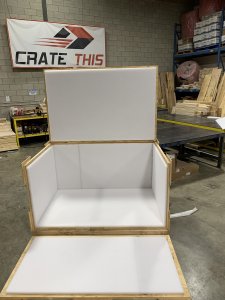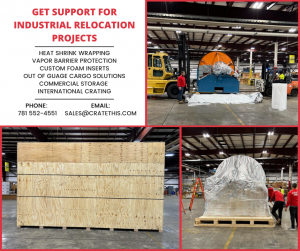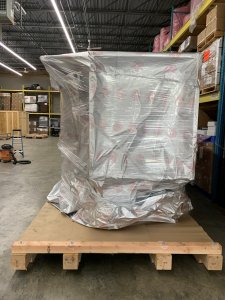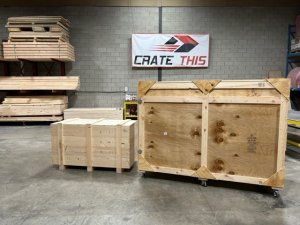
How To Choose The Right Crate For Your Shipment
How To Choose The Right Crate For Your Shipment Selecting the right crate for your shipment is a crucial step in ensuring that your goods arrive

The shipping industry has its own rules and regulations for moving any goods in and out of any country. Likewise, wooden crates come with a wide range of specifications for packing and shipping out goods. The crate needs to remain intact from the source to the final destination point. It is important that wooden crates comply with international regulations besides providing safety for keeping your goods safe during transit. So, what shipping crate specifications are necessary for international shipments?
Here at Crate This, located in Holbrook, Massachusetts we work with clients throughout the country to help them get access to well-designed crating. That includes crating designed for international shipments. Our crates meet all international shipping standards, and more importantly, they are tailored to your shipments needs to provide the optimal protection for your shipments. If you are interested in a quote for crate manufacturing, on-site packing, or one of our other crating services, please give us a call.

Many countries have made it compulsory to ban the export or import of wooden crates without having a “bug stamp” on the crate. Some countries won’t allow a crate to enter their port without an “ISPM 15 Certificate” in the documents list. Physically, each wooden crate should bear the “ISMP15” stamp. Without this stamp, your crate could be rejected at customs which can cause huge issues for your team. In this article we will cover what these stamps mean, how to get them, why they exist, and how to better handle international shipping.
ISPM 15 stamps certify that the wood used in crates is free from insects, pests, and infestation. All those countries covered under International Plant Protection Convention (IPPC) will accept only those wood crates, and wood packing materials that have bug stamps on them. This includes wooden cases, pallets, crates, drums, or other goods that need wood packing to keep them secure during sea passage. This practice is in order to stop the spread of plant-related diseases, pests, and other health hazards.
ISPM-15 rules mandatorily require the use of raw wood that has been fumigated or heat-treated to kill insects and fungus. After this treatment, each wood piece is stamped with ISMP15 with the company logo on it along with the date when treatment was completed. This is done in order to ensure health and safety measures are met with utmost care. During sea passage, untreated wood insects or fungus can damage other cargoes on board.
At Crate This, we only provide high-quality crating services. All of our crates are certified for international travel. We work directly with the Northeaster Lumber Manufacturers Association (NeLMA) to ensure that wooden packing materials including pallets, crates, etc. meet international standards. Contact us today for a free quote on crating and packaging services.

When manufacturing crates for international shipping there are a few things to keep in mind. As mentioned above in this article, it is important to be aware of international regulations that can affect whether or not your shipment will meet these international standards when it arrives at customs. Additionally, you need to make sure all paperwork is correctly filled and handled with your carrier and any additional third parties. Finally it is paramount that you consider how you package your goods. whether via air or ocean, international trips can put a beating on a shipment. You want to make sure your shipment is properly packed and protected both internally and externally. Visit our packaging page to learn how we protect international and domestic shipments.
Many things can potentially go wrong when shipping internationally. Your shipment could get damaged due to poor packaging. The best way to avoid this is to ensure that you use a durable crate that can withstand any damage caused by other goods moving in transit. Additionally you want to use different packing materials that protect goods from dirt, moisture, and other potential threats. Beyond damage, it is vital that paperwork and proper labeling is handled before a shipment leaves your country. Other countries have a right to return improperly prepared shipments or destroy them. Working with a logistics manager can help ensure that all international standards are met.
There are various ways to improve your shipping budget. One of the best things you can do is work with a freight forwarder that knows how to get the best shipping options for their clients. From a packing point of view, custom crating and package has many benefits. By using a custom packing company you decrease wasted materials by only getting the exact amounts of materials your shipment needs. You also greatly decrease the risk of damaged goods by having crating that is tailored to your shipment.
Small businesses can often struggle with international shipping strategies. On the one hand they are not a large company with a constant flow of imports/exports, on the other hand they are not a simple resident who only ships internationally infrequently. A small business should consider working with a local company that provides logistics and packing services. Consolidation for example is a great way to decrease shipping costs for a small business by finding other businesses that have LTL shipments. And with custom packing and crating, small businesses can decrease risks of damage to their property. LTL shipments do provide a level of increased risk because other shipments will be in the same shipping crate and can move during transit. Getting a custom crate with padding, strapping, and other materials can greatly improve the success of an international shipment.

How To Choose The Right Crate For Your Shipment Selecting the right crate for your shipment is a crucial step in ensuring that your goods arrive

What Are Some Of The Benefits of Custom Crating Services Whether you are shipping something domestically or internationally, one thing that can be acommon concern is

Relocation is a challenging logistical process. Whether you are moving a facility across the state, the country, or the globe, there are many different challenges to

Whatever you are shipping you probably want to make sure it arrives in the same condition they left in. The only way that can happen is

While 2023 saw some improvements in shipping and international logistics since the pandemic in 2020 and 2021, there are still concerns on how the pandemic has

Here at Crate This we provide high quality custom crating and packing services for businesses throughout Massachusetts. A common question is whether or not customized protection